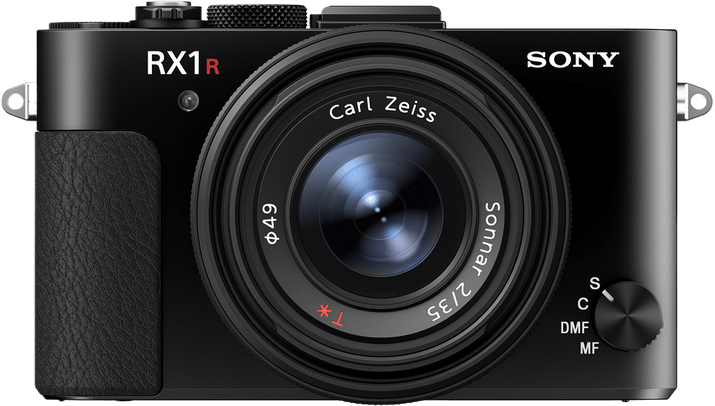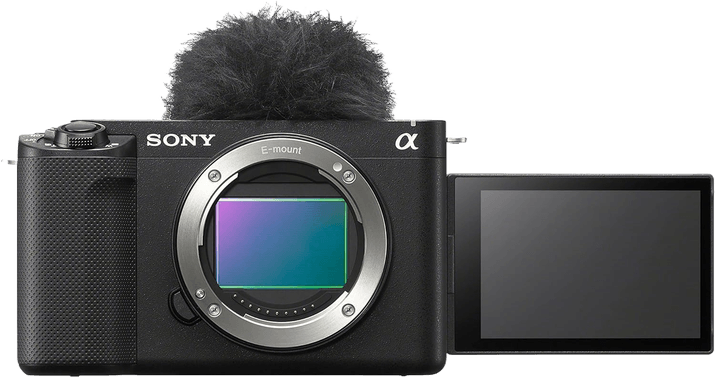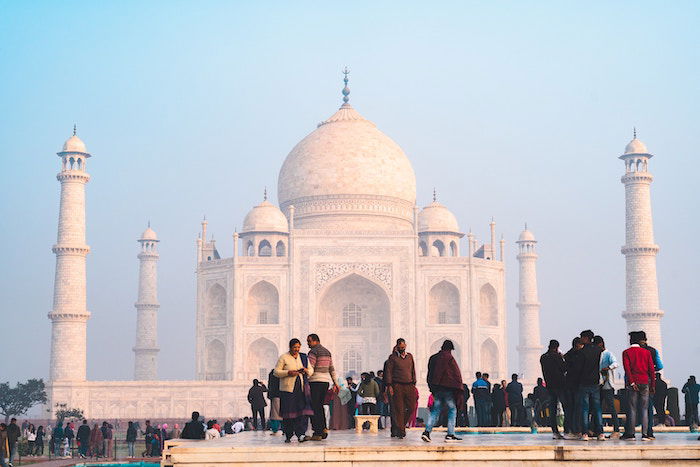Full frame compact cameras are becoming increasingly available. They allow you to capture more detail while having a highly portable and lightweight device.
The extra detail may not come in megapixels (MP), but full frame cameras can capture a wider dynamic range. This means richer colors and more details in the shadows and highlights.
Our top choice is the Sony a7C. Sony claims it is the world’s smallest and lightest full frame camera. It has great image quality, usability, and video options. It’s ideal for photographers who want a powerful compact camera.

What Is the Best Full Frame Compact Camera?
Here is a quick rundown of our top choices and why we like them! We go into detail in the section after. And we have a buying guide at the end that answers common questions about compact, full frame cameras.

- Smallest, lightest full frame camera
- 24.2 MP backside illuminated sensor
- 4K movie, full-pixel readout, HDR
- 15-stop dynamic range, 50 to 204,800 ISO
- 693 phase-detection, 425 contrast autofocus (AF) points

- 4K video resolution at 60 fps with 10-bit 4:2:2 color
- Easy video settings made for vloggers and content creators
- Built-in 5-axis image stabilization for photo and video
- Webcam functionality
- Wide expanded ISO range with minimum setting of 40

- Beautiful 42.4 MP full frame sensor clarity
- Sharp 35mm f/2.0 Zeiss Sonnar T lens
- Lightning-fast 399-point Hybrid AF
- Unique user-selectable low-pass filter
- Quality 2.4M-dot OLED electronic viewfinder

- Full frame sensor in an extremely compact camera body
- Incredible back-illuminated 61 MP sensor
- 12-bit video recording, 4K at 30 fps and Full HD at 120 fps
- Great connectivity for video equipment
- Compatible with Sigma Art lenses

- Stunning 47.3 MP full frame sensor
- Bright Summilux 28mm f/1.7 lens
- Impressive 50,000 ISO and 10 fps burst speed
- Convenient built-in Wi-Fi and NFC connectivity
- Crisp 3.68 MP OLED viewfinder
5 Best Full Frame Compact Cameras
Here are our recommended cameras in more detail.
1. Sony a7C

| Released |
Released
2020
|
| Sensor Format |
Sensor Format
Full Frame
|
| Lens Mount |
Lens Mount
Sony FE
|
| Megapixels |
Megapixels
24.2 MP
|
| Autofocus Points |
Autofocus Points
693
|
| Maximum ISO (Native) |
Maximum ISO (Native)
51200
|
| Frame Rate |
Frame Rate
10 fps
|
| In-body Stabilization |
In-body Stabilization
1
|
| Video |
Video
1
|
| Key Features |
Key Features
Interchangeable-lens camera, fast and reliable autofocus (AF) system, 4K video
|
| Best For |
Best For
Enthusiasts who want a high-quality, extremely portable camera for travel photography or other genres
|
The Sony a7C is a 24 MP camera that is the size of your hand. It is a camera that fully demonstrates the current technology of photography.
Fitting all its features and abilities into a camera body this size is a real achievement. Not just its full-frame sensor but also 4K abilities that record up to 30 fps (frames per second) and Full HD at 120 fps!
Sony has familiarity with making compact cameras with great usability. And these functions transfer seamlessly into their full frame compact cameras.
A simple array of buttons and a fold-out LCD screen add to this camera’s usability. You will also find a manual mode that is easy to access and control.
Another key point is the autofocus abilities of the a7C. It features Sony’s famously accurate AF system that now features real-time tracking and subject identification.
Plus, this compact is compatible with all Sony E-mount lenses. The lenses may seem out of place with such a small body. But using top lenses is key if you want the highest image quality possible.
All these elements together make for a great mix of professional features in an extremely compact size. If you’re looking for a reliable full frame compact camera, the a7C ticks all the right boxes.
2. Sony ZV-E1

| Released |
Released
2023
|
| Sensor Format |
Sensor Format
Full Frame
|
| Lens Mount |
Lens Mount
Sony E
|
| Megapixels |
Megapixels
12 MP
|
| Autofocus Points |
Autofocus Points
759
|
| Maximum ISO (Native) |
Maximum ISO (Native)
102400
|
| Frame Rate |
Frame Rate
10 fps
|
| In-body Stabilization |
In-body Stabilization
1
|
| Video |
Video
1
|
| Key Features |
Key Features
12-bit 4K video, Auto Framing
|
| Best For |
Best For
Photographers, vloggers, and content creators who want great video features
|
The Sony ZV-E1 hit the markets in May 2023 and was aimed to take the vlogging camera market by storm. Its specs show that it was designed to be used as a video camera.
It doesn’t boast much in the megapixels department, only capturing up to 12 MP. But it can capture full 12-bit 4K video at 60 fps. And it also captures 120 fps as an upgradable feature in Full HD.
The camera provides a range of features that make shooting professional footage easy. Its five-axis in-body image stabilization (IBIS) helps a lot.
And some of its AI features help it go one step further. One of its new AI features is Auto Framing. This is extremely handy for content creators and vloggers.
It allows you to leave your camera on a tripod. And the camera will follow your subject around and crop the scene to mimic professional video composition!
The ZV-E1 also includes real-time subject recognition for constant sharp focus. And it features a slow-motion mode where you can get up to 240 fps.
I recommend this camera for people who want to prioritize video. This could be anything from recording family memories or travel or if you need a stay-at-home webcam.
3. Sony DSC-RX1R II

| Released |
Released
2015
|
| Sensor Format |
Sensor Format
Full Frame
|
| Lens Mount |
Lens Mount
Fixed
|
| Megapixels |
Megapixels
42.4 MP
|
| Autofocus Points |
Autofocus Points
399
|
| Maximum ISO (Native) |
Maximum ISO (Native)
25600
|
| Frame Rate |
Frame Rate
5 fps
|
| Video |
Video
1
|
| Key Features |
Key Features
High-megapixel sensor, fixed, large-aperture 35mm Zeiss lens, user-selectable optical variable low-pass filter
|
| Best For |
Best For
Travel and street photographers or those who like to shoot in wide-angle formats
|
The Sony DSC-RX1R II is a 42.4 MP compact camera. Sony claims it is the ultimate full frame compact camera. But you are looking at a hefty price to pay for it.
If you look at its specs, it’s no surprise the price is so high. You will find a backlit sensor, wide and fast autofocus abilities, and Full HD video in this camera.
This Sony camera has a fixed 35mm f/2 lens. I am a fan of fixed-lens cameras as I find them more challenging to shoot with.
They force you to be more active with your photography. You either have to walk up close to your subject or take steps back.
Interchangeable lens cameras give you greater control over your aesthetic. So this may be a dealbreaker. But you will still get amazing results from this beautiful ZEISS Sonar T lens.
Sony also claims it has the world’s first “user-selectable optical variable low-pass filter.” These help increase image quality. They do this by reducing the false colors caused by high-frequency waves.
The camera allows you to switch the variable low-pass filter off and on. And there’s also a mode to balance between the two. Having it off prioritizes image resolution.
The DSC-RX1R II is an exceptional full frame compact camera. I suggest it for photographers who prefer to shoot with wide-angle lenses. And it is perfect as a travel or street photography camera.
4. Sigma fp L

| Released |
Released
2021
|
| Sensor Format |
Sensor Format
Full Frame
|
| Lens Mount |
Lens Mount
Leica L
|
| Megapixels |
Megapixels
61 MP
|
| Autofocus Points |
Autofocus Points
49
|
| Maximum ISO (Native) |
Maximum ISO (Native)
25600
|
| Frame Rate |
Frame Rate
10 fps
|
| Video |
Video
1
|
| Key Features |
Key Features
Extremely high-resolution sensor, phase detection AF, 4K video
|
| Best For |
Best For
Promotional videos, fashion shoots, or any type of professional tripod photography
|
The Sigma fp L is a full frame compact camera stripped back to its bare essentials. This isn’t an issue for photographers who know what they want. But it is not ideal for those just starting with photography.
This Sigma camera offers you a back-illuminated 61 MP sensor. And you will also find 12-bit cinema-level recording that can shoot 30 fps at 4K or 120 fps in Full HD.
The body is so stripped back that not even a viewfinder is attached! But you can buy one with an attachment or buy an EVF separately. And the camera body has a tilt-able feature attached to its side.
Although there aren’t many buttons, this compact camera is well set up for professional use. It offers exceptional manual controls that many photographers wish were as accessible in their own cameras.
Sigma also has another version, the Simga fp, which is available for less. But it doesn’t have the (maybe excessive) 61 MP that the fp L has.
Another big main difference apart from more megapixels is phase detection AF. This allows for subject recognition and tracking, increasing the autofocus’s reliability.
The fp L is compatible with Sigma L-mount lenses. The Sigma Art lens range is well known for producing beautiful imagery.
And if you were to use one of these lenses with this extremely compact-sized camera, you would have a fantastic high-end system. Good enough to shoot up-scale promotional videos and fashion shoots!
5. Leica Q2

| Released |
Released
2019
|
| Sensor Format |
Sensor Format
Full Frame
|
| Lens Mount |
Lens Mount
Fixed
|
| Megapixels |
Megapixels
47.3 MP
|
| Autofocus Points |
Autofocus Points
225
|
| Maximum ISO (Native) |
Maximum ISO (Native)
50000
|
| Frame Rate |
Frame Rate
10 fps
|
| Video |
Video
1
|
| Key Features |
Key Features
High-resolution sensor, 28mm f/1.7 lens with digital zoom, fast focus, 4K video
|
| Best For |
Best For
People who can afford high-end photography equipment
|
The Leica Q2 belongs to a legendary line of Leica cameras and fits in perfectly with modern photographic needs. And it is the smallest camera Leica produces.
The Q2 is a fixed-lens camera with a beautiful 28mm f/1.7 aspherical lens. This lens is so well constructed that you likely wouldn’t want to swap lenses anyway.
The fixed lens isn’t too much of an issue. Leica has included a digital zoom function in this camera. This lets you switch between 28, 35, 50, and 75mm focal lengths.
This is possible thanks to its powerful 47.3 MP sensor. And Leica also claims it is able to preserve the original 47.3 megapixels throughout its digital zoom range.
You will also find that the Leica Q2 is built for fast, on-the-go photography. So it perfectly fits the brief for compact cameras.
The Q2’s autofocus system allows fast focusing speeds of up to 0.15 seconds. And this is combined with an impressive burst shooting of 10 fps.
This Leica also records 4K video at 30 fps or Full HD at 120 fps. And it comes in a selection of different colors for those who like to have stylized equipment.
So with all its incredible abilities, why does the Q2 feature so far down this list? Experienced photographers will know the answer… it’s the price tag!
The Q2 caters to the high-end portion of the photographic market. So this camera is for people who can afford it. If you can afford it, you won’t find a better full frame compact camera!
Full Frame Compact Camera Buyers Guide (FAQs)
We answer some frequently asked questions about full frame compacts to help you in your buying decisions.
What Are the Benefits of a Full Frame Compact Camera?
The obvious benefit of a full frame compact camera is its super-portable size. And you can get more portable cameras, but these have larger sensor frames.
You may also find half frame cameras with similar megapixel counts. But megapixels aren’t everything.
A larger sensor size means more light and information is being recorded. This results in a greater dynamic range and overall better image quality.
Another benefit is that a reduced camera size results in a very simplistic system. This is perfect for those who aren’t bothered about the camera settings but the images themselves.
An easy-to-use camera makes for easy photography.
What Features Should I Consider When Purchasing a Full Frame Compact Camera?
The most important features to consider are its image quality and its abilities. Any camera that produces over 20 MP will produce sharp enough photos for most platforms.
You will then need to consider what you will use the camera for.
Many people look for a compact camera for travel. If this is the case, you may want a camera with good video features to help capture all your memories.

You may also want to consider the lenses available for your compact, full frame camera. Some of the options on this list have a fixed lens.
So you should ask yourself if you want the option to buy more lenses. This does mean more variety but also means more money.
What Is the Best Full Frame Compact Camera for Beginners?
We suggest the Sony a7C for beginners. This is because of its great abilities, usability, and quality for a low price. It’s perfect for anyone who wants to start out with a full frame compact camera.
It also takes any Sony E-mount lenses, which are great to acquire if you want to move on to more professional equipment in the future.
Conclusion: The Best Full Frame Compact Camera
From this list, we can see that Sony is currently dominating the full frame compact camera market. They provide three different cameras that all have their own unique abilities and shooting styles.
One of these models will suit your needs. But modern full frame mirrorless cameras are getting smaller and smaller. So it’s worth checking if these are compact enough for you.
If you want to shoot content, choose the Sony ZV-E1. If you want the highest-megapixel camera, choose the Sony DSC-RX1R II. And if you’re looking for an all-rounder, choose the Sony a7C. It is our favorite option. And it is great to see an interchangeable lens camera that’s the size of your hand!


